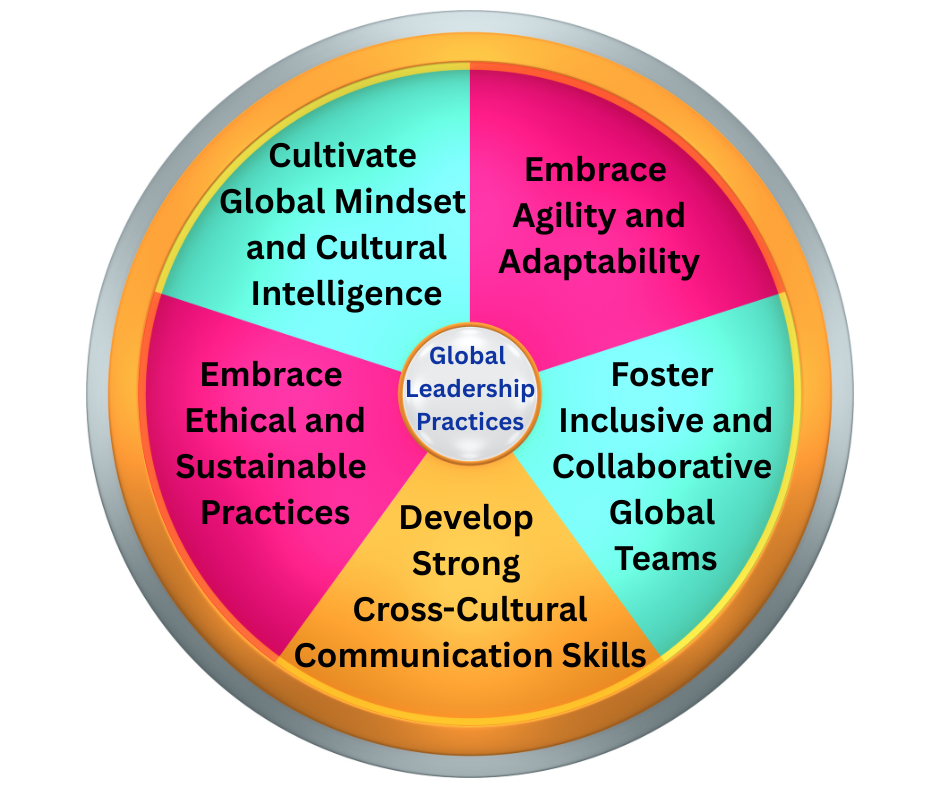
In today’s increasingly interconnected world, effective global leadership is paramount for organizations looking to achieve international growth. This article explores five essential leadership practices for thriving in global markets, providing a roadmap for navigating complex cultural landscapes and achieving sustainable success.

1. Cultivate Global Mindset and Cultural Intelligence:
The cornerstone of effective global leadership lies in cultivating a genuine global mindset. This goes beyond simply acknowledging cultural differences; it involves actively seeking to understand, appreciate, and leverage diverse perspectives. Leaders must develop high cultural intelligence (CQ), the ability to effectively navigate and adapt to various cultural contexts. This includes:
- Cultural Awareness: Recognizing your own cultural biases and understanding how they might influence interactions.
- Cultural Knowledge: Acquiring information about different cultural norms, values, and communication styles.
- Cultural Skills: Developing the ability to adapt your behavior and communication to suit different cultural environments.
- Cultural Metacognition: Reflecting on your cultural interactions and adjusting your approach for future engagements.
By prioritizing CQ, leaders can build stronger relationships with international partners, foster inclusive global teams, and make more informed decisions that resonate across diverse markets.
2. Embrace Agility and Adaptability:
Global markets are characterized by constant flux. Economic shifts, political changes, technological advancements, and evolving consumer preferences demand leaders who can embrace ambiguity and adapt swiftly. This requires:
- Strategic Flexibility: Being willing to adjust long-term plans based on emerging trends and unforeseen challenges.
- Operational Agility: Implementing flexible processes and structures that allow for rapid responses to market changes.
- Learning Agility: Continuously seeking new knowledge and adapting leadership styles to suit different contexts.
- Resilience: Bouncing back from setbacks and viewing challenges as opportunities for growth and innovation.
Leaders who foster a culture of agility empower their teams to navigate uncertainty effectively and capitalize on emerging opportunities in diverse global landscapes.
3. Foster Inclusive and Collaborative Global Teams:
Building high-performing global teams requires more than just bringing together individuals from different locations. It demands a conscious effort to foster inclusivity and collaboration. Effective global leaders:
- Champion Diversity: Recognize the unique strengths and perspectives that individuals from diverse backgrounds bring to the table.
- Promote Psychological Safety: Create an environment where team members feel comfortable expressing their ideas and taking risks, regardless of their cultural background or location.
- Leverage Technology for Communication: Utilize various communication tools effectively to bridge geographical distances and facilitate seamless collaboration.
- Develop Shared Vision and Goals: Ensure all team members, regardless of their location, are aligned with the overarching objectives and understand their contribution to the global strategy.
By nurturing inclusive and collaborative global teams, leaders can unlock innovation, enhance problem-solving capabilities, and drive stronger results across international markets.
4. Develop Strong Cross-Cultural Communication Skills:
Effective communication is paramount in any business setting, but it becomes even more critical in the context of global markets. Leaders must be adept at navigating linguistic differences, understanding nonverbal cues, and adapting their communication styles to different cultural norms. This involves:
- Active Listening: Paying close attention to both verbal and nonverbal cues and seeking clarification to ensure understanding.
- Clear and Concise Language: Avoiding jargon, slang, and culturally specific references that may not be understood by international audiences.
- Empathy and Perspective-Taking: Trying to understand the other person’s point of view from their cultural context.
- Utilizing Diverse Communication Channels: Choosing the most appropriate communication methods for different situations and cultural preferences.
Mastering cross-cultural communication enables leaders to build trust, avoid misunderstandings, and foster stronger relationships with stakeholders across the globe.
5. Embrace Ethical and Sustainable Practices:
In today’s interconnected world, ethical and sustainable practices are not just a matter of social responsibility; they are crucial for long-term success in global markets. Leaders must:
- Uphold High Ethical Standards: Adhere to consistent ethical principles across all international operations, even when faced with varying local regulations.
- Prioritize Sustainability: Integrate environmental and social considerations into business strategies, recognizing the interconnectedness of global ecosystems and communities.
- Engage in Responsible Sourcing and Production: Ensure ethical labor practices and minimize environmental impact throughout the supply chain.
- Demonstrate Transparency and Accountability: Communicate openly about ethical and sustainability efforts and hold the organization accountable for its impact.

By championing ethical and sustainable practices, leaders can build a strong reputation, attract conscious consumers and investors, and contribute to a more equitable and sustainable global future.
Thriving in global markets is not merely about expansion; it’s about leading with awareness, adaptability, and a genuine commitment to understanding and engaging with the diverse world around us. By embracing these five leadership practices, organizations can navigate the complexities of the international landscape and achieve sustainable success on a global scale.